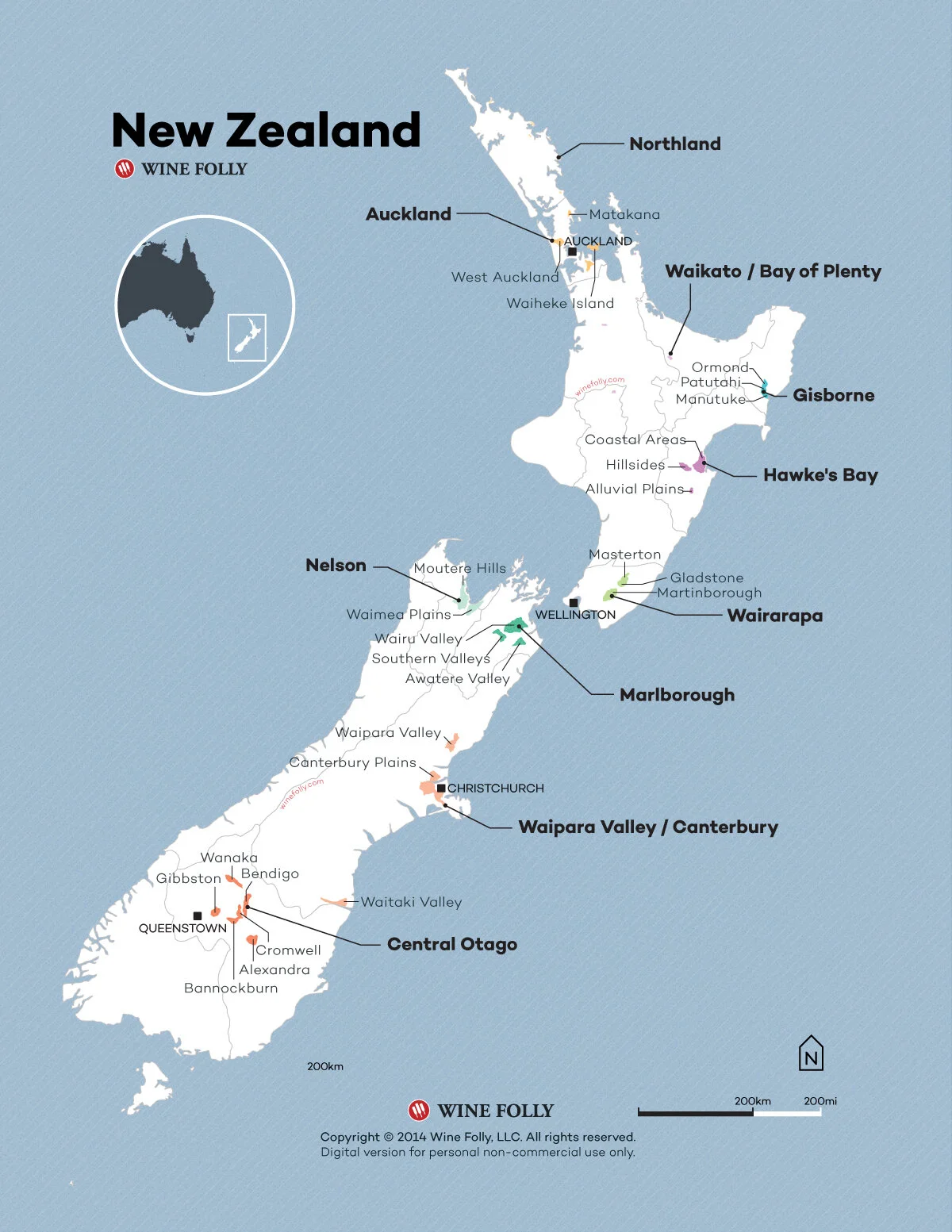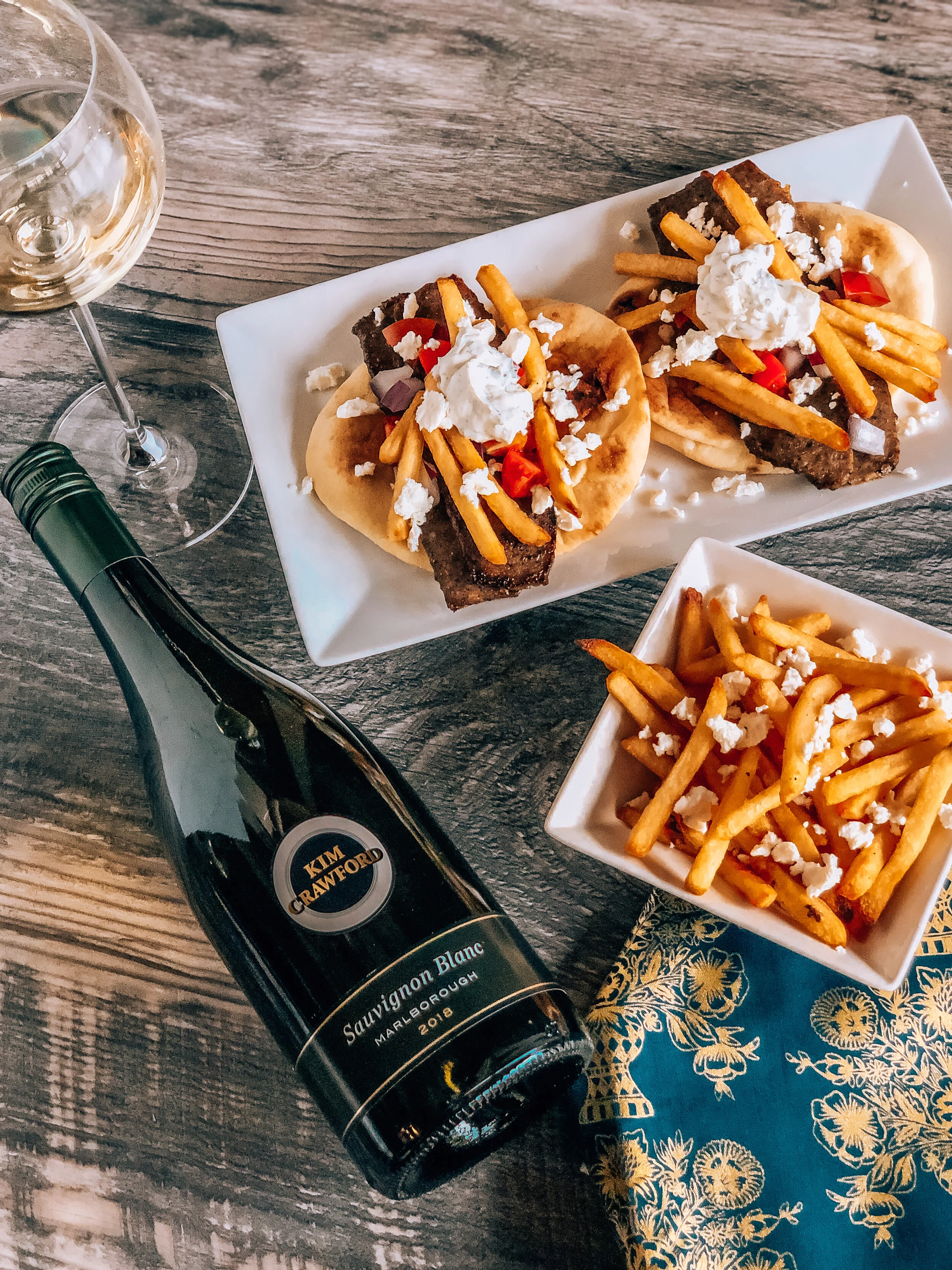A Guide to New Zealand’s Top Wine Regions
As a first of many wine region spotlights, and I’m thrilled to focus on the unique and beautiful region of New Zealand. This post is a quick guide to the most well known wine growing regions across the country, but be sure to listen to The Wine CEO Podcast episodes #34 and #35 to hear fun facts about New Zealand as well as a crazy legend about how French pinot noir cuttings found their way to Auckland!
History & Quick Overview of New Zealand
New Zealand is located in the Southern Hemisphere between the 35th and 47th parallels. All of the major grape growing regions around the world lie between the 30th and 50th parallels as these are the most temperate climates for growing grapes (not too hot and not too cold). Because of the earth’s tilt as it moves around the sun, the seasons are opposite in Northern and Southern Hemispheres. So it’s winter in the northern hemisphere when it’s summer in the south and vice versa. What this means is that while the northern hemisphere harvests grapes in late September, October, and early November; the Southern Hemisphere is harvesting in late March, April, and early May. As part of the Southern Hemisphere, New Zealand has their harvest in March-May.
New Zealand is a country made up of 2 main islands in the middle of the South Pacific Ocean (there are lots of smaller islands off the coast, but the two large ones are the home to the country’s wines). The two main islands are simply called - the North island and the South Island.
Fun fact, the vineyards in the South Island are actually the most southern vineyards in the entire world. And because of how close they are to the international date line, they’re actually the first grapes to see sunshine each day - pretty cool!
New Zealand is a younger wine region by most standards. Although there have been grape vines there since 1819, it wasn’t until the 1980s that New Zealand wines began to receive world acclaim and the popularity of New Zealand Sauvignon Blanc rose. A lot of people attribute this to the prohibition culture and social movement against wine that was a part of New Zealand’s culture for decades. Believe it or not, it wasn’t until after WW2 that wine bottles were sold in shops and the 1960s that wine was sold in restaurants. So there has been a long history of deterring wine production, sale, and consumption which kept New Zealand from becoming a world renowned wine region sooner. But as this prohibition culture started to dissolve, great wine producers started sprouting up all across New Zealand. The world acclaim specifically for New Zealand Sauvignon Blanc made the number of New Zealand wineries jump from 30 to over 700 between the mid 90s and 2000s. But even with this number of wineries, the country is still very small and accounts for less than 1% of the world’s wine production. New Zealand also exports 90% of their wine - that’s a lot!
New Zealand has a cool, maritime climate which makes it perfect for growing thinner skinned grapes. Although there are over 25 grape varietals grown across the country, Sauvignon Blanc and Pinot Noir reign king.
New Zealand’s wine regions are spread across the North Island and South Island.
Although over 25 grape varieties are grown across the region, Sauvignon Blanc and Pinot Noir reign king.
North Island
The North Island is predominantly known for the regions of Hawke’s Bay, Gisborne, Auckland, and Wairarapa. This whole island is slightly warmer throughout the year than the South Island because it’s closer to the equator. This makes it much easier for the wine makers in this region to grow Syrah, Merlot, Chardonnay, Cabernet Sauvignon, and other grapes that require a bit more sunlight.
Auckland: Aukland is the most northwestern wine region in New Zealand and is mostly known for Chardonnay and red blends from Merlot and Cabernet Sauvignon. There has been an increase in Syrah plantings over the past few years in Auckland as well. The region spreads out all around the city of Aukland and although it doesn’t produce the most wine in New Zealand, it actually has the largest number of wineries in the country. The climate in Aukland is warm, but rainy and humid. There’s a lot of cloud cover in this region that can help moderate sunlight hours, but the intense amount of rain can also create problems with rot. For a smaller region, they are producing some really amazing wines. (There’s a really interesting legend about how Pinot Noir made its way to Auckland via a rugby player!….Be sure to listen to The Wine CEO Podcast Episode #34 to hear this unique story!)
Gisborne: Moving clockwise from Auckland we come next to Gisborne. This region sits along the north eastern coast and is known for Chardonnay and Pinot Gris. They’re especially known for their unique Chardonnays that have tropical fruit and honey notes that make for really unique, bold wines. Gisborne gets a lot of rain along the coast, but is still warmer than most New Zealand regions. This weather makes it perfect for chardonnay. Overall it’s a fairly small region and has a lower number of wineries compared to the other North Island regions.
Hawke’s Bay: Next up is Hawke’s Bay which is along the central eastern coast of the North Island. It is known for Cabernet Sauvignon, Merlot, Chardonnay, Sauvignon Blanc, Pinot Gris, and a small amount of Syrah. Hawke’s Bay is actually the second largest wine region in the country and also the driest of all of the regions in the North Island. The leading variety here is Chardonnay, but there’s a long history of red wine as well. Cabernet Sauvignon put this region on the map due to the fertile and gravelly soil that reminded many winemakers of Bordeaux. Today Merlot and Syrah have overtaken Cabernet Sauvignon in the number of vines planted, but all of these red grapes are still used in many delicious blends coming out of this region.
Wairarapa: Last but not least is Wairarapa. This region is in the southern tip of the North island, where the country’s capital of Wellington is located. Wairarapa is known for Pinot Noir, Sauvignon Blanc and some Pinot Gris. The most important sub region within Wairarapa is by far Martinborough, which has gained world acclaim for outstanding pinot noirs. The region is compared often to Burgundy, which is also known for Pinot Noir, due to their similar climates. There’s a large mountain range that helps create a really dry climate in Martinborough that is perfect for growing Pinot Noir. Overall, there aren’t a ton of wineries here, but the few that are - make really delicious wines.
Wines to try from the North Island
Palliser Estate: This winery offers Pinot Noir, Sauvignon Blanc, and Pinot Gris from Martinborough.
Ata Rangi: Amazing Pinot Noirs from Martinborough
Dry River: Delicious Pinot Noirs from Martinborough
South Island
In the South Island, the main regions of note are Marlborough, Caterbury, Waipara, and Central Otago.
Marlborough: Marlborough is known almost exclusively for Sauvignon Blanc. It produces 70% of New Zealand wine and over 85% of the country’s Sauvignon Blanc. It’s also fitting that we discuss Marlborough first because it was actually the first area on the South Island where grape vines were planted. The region is made up of multiple valleys and each imparts specific flavor profiles to the grapes. (For example, some areas offer more irrigation while others have unique soil blends.) Often winemakers in Marlborough will harvest Sauvignon Blanc grapes from multiple valleys and blend them to find a balanced flavor. Marlborough does have some Pinot Noir, Chardonnay, Riesling, and Pinot Gris; but, it’s mostly known for Sauvignon Blanc. Many producers here age their wine in stainless steel tanks while some age on old French oak barrels that impart little flavor to the wine. Basically, there's little to no oak influence so these wines taste clean, crisp, and refreshing.
Caterbury & Waipara: Up next are the regions of Caterbury and Waipara. I combined these two because they are fairly small producing regions located on the central eastern coast of the South Island. They’re also both located right next to the large city of Christchurch. These areas are known predominantly for Pinot Noir and Sauvignon Blanc, but there is some Riesling and Pinot Gris grown here as well.
Central Otago: Last but not least is Central Otago, which is in the south east region of the South Island. This area is known for Pinot Noir and is definitely the second most well known region in the South Island, next to Marlborough. There is a small amount of Pinot Gris, Chardonnay, and Riesling grown here - but Pinot Noir is definitely the main attraction. The reason for this is the unique red colored soil made of clay, lime, and gravel; which imparts unique minerality to the grapes. Additionally the climate in Central Otago is rather dry and sunny, helping the Pinot Noir grapes to develop nice fresh fruit flavors.
Wines to try from the South Island
Cloudy Bay: Sauvignon Blanc, Marlborough
Kim Crawford: Sauvignon Blanc, Marlborough
Brancott Estate: Sauvignon Blanc, Marlborough
Oyster Bay: Pinot Noir, Marlborough
Dog Point: Pinot Noir, Marlborough
Wild Earth: Pinot Noir, Central Otago
Typical Grape Varietal Characteristics for New Zealand
Typically New Zealand Sauvignon Blancs are stylistically known for having notes of grapefruit, passionfruit, ripe pear, tropical fruits, kiwi, and herbal notes that a lot of folks equate to fresh cut grass and herbs.
The Pinot Noirs can range in flavor across the North and South Islands, but they tend to have notes of cherry, cranberry, mushroom, raspberry and spices or vanilla.
Great Food Pairings with New Zealand Wines
With these unique flavor profiles, you have a lot of great options to pair New Zealand Sauvignon Blanc and Pinot Noirs with food. NZ is surrounded by ocean, so there's a lot of seafood in their cuisine. New Zealand Sauvignon blancs go really nicely with oysters, shrimp, light white fish, and almost anything that is light and needs acid. Because of the herbal flavors, they also pair nicely with heavily herbed light dishes. So for example, think about a shrimp pasta with lemon and fresh parsley - this would be great with New Zealand Sauvignon Blanc.
Additionally, New Zealand Sauvignon Blancs pair nicely with salads because of the herbal and vegetal flavors. One thing that a lot of folks don’t expect is that New Zealand Sauvignon Blancs actually go really well with asian foods. The tropical fruit and lime notes are delicious with South Pacific island cuisine. (And if you aren’t familiar with Fiji and the Polynesian islands, think about fish with soy sauce or lime and coconut milk as this is classic cuisine to the region).
New Zealand Pinot Noirs pair nicely with lamb because of the earthier and spicier notes. But, because they are also light, fruity, and acidic, they also pair well with duck and chicken. My personal favorite though is salmon. New Zealand Pinot Noir is light enough to not overpower salmon making for a delicious combination.
Fun Fact:
One of the things that New Zealand is known for is utilizing the Stelvin Closure or Screw Cap in almost all of their wines. You would be hard pressed to find a wine with a cork in it in this country and culturally it’s more odd to see a wine with a screw cap than a cork throughout the islands. This may seem counterintuitive, but if you remember listening to The Wine CEO Podcast Episode #18, then you know that screw caps are becoming more and more popular around the world because they are actually a safer way to seal bottles than natural corks. Screw caps have been widely accepted in New Zealand for this reason for years and it’s truly just a common practice in the winemaking culture and for all of the New Zealand wine consumers to expect screw caps.
I hope you all enjoyed this beginner’s guide to New Zealand Wine Regions! Be sure to leave a comment below if you learned something new!


